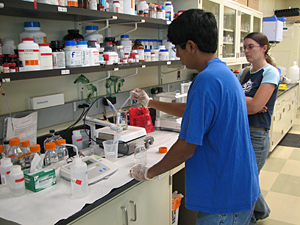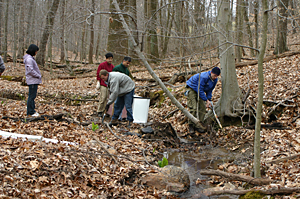
- Rozovsky wins prestigious NSF Early Career Award
- UD students meet alumni, experience 'closing bell' at NYSE
- Newark Police seek assistance in identifying suspects in robbery
- Rivlin says bipartisan budget action, stronger budget rules key to reversing debt
- Stink bugs shouldn't pose problem until late summer
- Gao to honor Placido Domingo in Washington performance
- Adopt-A-Highway project keeps Lewes road clean
- WVUD's Radiothon fundraiser runs April 1-10
- W.D. Snodgrass Symposium to honor Pulitzer winner
- New guide helps cancer patients manage symptoms
- UD in the News, March 25, 2011
- For the Record, March 25, 2011
- Public opinion expert discusses world views of U.S. in Global Agenda series
- Congressional delegation, dean laud Center for Community Research and Service program
- Center for Political Communication sets symposium on politics, entertainment
- Students work to raise funds, awareness of domestic violence
- Equestrian team wins regional championship in Western riding
- Markell, Harker stress importance of agriculture to Delaware's economy
- Carol A. Ammon MBA Case Competition winners announced
- Prof presents blood-clotting studies at Gordon Research Conference
- Sexual Assault Awareness Month events, programs announced
- Stay connected with Sea Grant, CEOE e-newsletter
- A message to UD regarding the tragedy in Japan
- More News >>
- March 31-May 14: REP stages Neil Simon's 'The Good Doctor'
- April 2: Newark plans annual 'wine and dine'
- April 5: Expert perspective on U.S. health care
- April 5: Comedian Ace Guillen to visit Scrounge
- April 6, May 4: School of Nursing sponsors research lecture series
- April 6-May 4: Confucius Institute presents Chinese Film Series on Wednesdays
- April 6: IPCC's Pachauri to discuss sustainable development in DENIN Dialogue Series
- April 7: 'WVUDstock' radiothon concert announced
- April 8: English Language Institute presents 'Arts in Translation'
- April 9: Green and Healthy Living Expo planned at The Bob
- April 9: Center for Political Communication to host Onion editor
- April 10: Alumni Easter Egg-stravaganza planned
- April 11: CDS session to focus on visual assistive technologies
- April 12: T.J. Stiles to speak at UDLA annual dinner
- April 15, 16: Annual UD push lawnmower tune-up scheduled
- April 15, 16: Master Players series presents iMusic 4, China Magpie
- April 15, 16: Delaware Symphony, UD chorus to perform Mahler work
- April 18: Former NFL Coach Bill Cowher featured in UD Speaks
- April 21-24: Sesame Street Live brings Elmo and friends to The Bob
- April 30: Save the date for Ag Day 2011 at UD
- April 30: Symposium to consider 'Frontiers at the Chemistry-Biology Interface'
- April 30-May 1: Relay for Life set at Delaware Field House
- May 4: Delaware Membrane Protein Symposium announced
- May 5: Northwestern University's Leon Keer to deliver Kerr lecture
- May 7: Women's volleyball team to host second annual Spring Fling
- Through May 3: SPPA announces speakers for 10th annual lecture series
- Through May 4: Global Agenda sees U.S. through others' eyes; World Bank president to speak
- Through May 4: 'Research on Race, Ethnicity, Culture' topic of series
- Through May 9: Black American Studies announces lecture series
- Through May 11: 'Challenges in Jewish Culture' lecture series announced
- Through May 11: Area Studies research featured in speaker series
- Through June 5: 'Andy Warhol: Behind the Camera' on view in Old College Gallery
- Through July 15: 'Bodyscapes' on view at Mechanical Hall Gallery
- More What's Happening >>
- UD calendar >>
- Middle States evaluation team on campus April 5
- Phipps named HR Liaison of the Quarter
- Senior wins iPad for participating in assessment study
- April 19: Procurement Services schedules information sessions
- UD Bookstore announces spring break hours
- HealthyU Wellness Program encourages employees to 'Step into Spring'
- April 8-29: Faculty roundtable series considers student engagement
- GRE is changing; learn more at April 15 info session
- April 30: UD Evening with Blue Rocks set for employees
- Morris Library to be open 24/7 during final exams
- More Campus FYI >>
2:37 p.m., Oct. 9, 2008----The National Science Foundation (NSF) has awarded a UD-led team of researchers a $540,000 grant to study the sources of dissolved organic matter and how it is transported in the watershed. The study will be conducted at the Fair Hill Natural Resources Management Area in Maryland, a few minutes drive from UD's Newark campus.
“The tea-like or brown color that you see in stream or lake waters is because of dissolved organic matter,” explained Shreeram Inamdar, professor of bioresources engineering.
Inamdar is leading the grant-funded research group, which includes Delphis Levia, professor of geography, and Harsh Bais, professor of plant and soil sciences. Joining them will be Myron Mitchell, professor of environmental and forest biology at the State University of New York in Syracuse, and Durelle Scott, professor of biological systems engineering at Virginia Tech.
“The beauty of this team is that our expertise and our interests are very complementary,” Inamdar said. “Each of us will look at how various parts of the watershed including the vegetation, soils, wetlands and streams influence the dynamics of dissolved organic matter.”
Dissolved organic matter includes dissolved organic carbon (DOC) and dissolved organic nitrogen (DON), and when these components mix with runoff waters, they have important environmental implications, Inamdar said, because that runoff water will eventually end up in streams, rivers or lakes, where it is collected and chlorinated to become drinking water.
If the raw water has high levels of DOC and DON when it is chlorinated, Inamdar said, it will generate what are known as disinfection byproducts, some of which are carcinogenic. DON can also contribute to eutrophication or excess growth of algae in water bodies like the Chesapeake Bay, Inamdar said.
“Thus, the better you understand the dynamics of dissolved organic nitrogen,” Inamdar said, “the better you will be able to address the pollution of water bodies like the Chesapeake Bay.”
This project will provide valuable interdisciplinary instrumentation, sampling and laboratory research experience for graduate and undergraduate students. The professors involved with the project already have started using the watershed as an educational site through class field visits and demonstrations. The researchers and their UD students also will participate in educational programs and field visits for K-8 students visiting Fair Hill Nature Center.
The study site will be affiliated with the Center for Critical Zone Research at UD and will be developed as a long-term experimental watershed. “This study will further enhance our environmental research program and will directly contribute to the University's strategic initiatives under the Path to Prominence,” Inamdar said.
Graduate and undergraduate students interested in participating in the research should e-mail Inamdar at [Inamdar@udel.edu] for more information. There is a doctoral assistantship available immediately.



